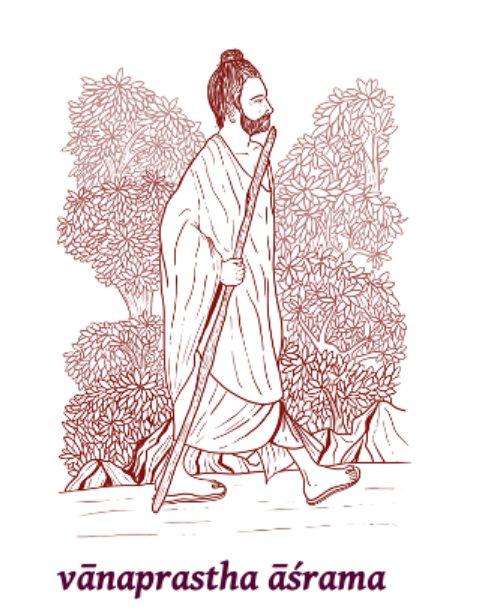Vedic culture/civilization has two components, one to follow varṇāśrama-dharma and second to become God (Krishna) Conscious. Lord Krishna Himself has created Varṇāśrama system – cātur-varṇyaṁ mayā sṛṣṭaṁ. That complete Vedic culture which was prevalent in ancient India up until 100 years ago, Srila Prabhupada wanted to transplant it to the west in its intact form and save human society all over the world from gliding down to hellish life. Having concern for his own society (ISKCON) Śrīla Prabhupāda wanted to establish daiva varṇāśrama-dharma, which was half of his mission. However, the management of ISKCON in Western countries were unaware this Vedic cultural system. Therefore, it remained obscure for the ISKCON managers up until now.
Nevertheless, he began talking about four āsramas as early as 1968. He wanted that all devotees should strive for spiritual advancement and stop sense gratification. He encouraged everyone to go through varṇāśrama system and specifically up to Vānaprastha-āśrama. According to him every man and woman should be trained for this purpose. Every man and woman should be trained for this purpose. He wanted to establish varṇāśrama-dharma, specifically, daiva varṇāśram a-dharma, in ISKCON to save human society from gliding down to hellish life. if established systematically, it will change humankind. Varṇāśrama-dharma trains one to completely retire from worldly life in his or her remaining days of life and prepares one for going back to Godhead. (SB. 5.19.19, purport) “(One should) prepare for the remaining days of one’s life for spiritual culture. That is called vānaprastha. (Lecture on SB. 7.6.6–9, Montreal, June 23, 1968). According to Vedic civilization one should get out of materialistic life -Pañcāśordhvaṁ vanaṁ vrajet means one must climb out of the gṛham andha-kūpam (the “blind well of householder life”) and vanaṁ vrajet (go to the forest). Vrajet means “compulsory.
Śrīla Prabhupāda gave all his disciples brāhmaṇa dīkṣā. He wanted all brāhmaṇa men and women to accept vānaprastha, and then for the men to take sannyāsa. He mentioned, “One should not simply remain at home until the time of death, but should separate from family life at a timely moment and prepare himself to go back to Godhead.” (SB. 4.23.1–3, purport) If a man leaves home and dies without his family’s knowing, that is considered to be a glorious death.” He propagated the idea that systematically planned separation is better than forced separation. He argued that if one will be separated from his or her family in one way or another, why not separate willingly.
“In any case, one should wind down material life until nothing is left so that one will have to totally depend on the Supreme Lord’s mercy. Life is the preparation and death is the final examination.”
Śrīla Prabhupāda himself took vānaprastha. “I myself passed my life as a householder until 1950, when I retired from family life as a vānaprastha. I was preaching and writing for eight or nine years as vānaprastha. “Letter to Mahātmā, Bombay, May 1, 1974) (Austerity, study of Vedic literature, and philosophical research are meant for the vānaprasthas, or retired persons.)
What is vanaprastha-asrama?
The vānaprastha order is complete retirement from householder life, a time when one prepares oneself for going back to Godhead. It can be both a physical and mental place where one cultivates spiritual life, where culture of the spiritual is foremost.”
The main qualifications for entering vānaprastha for men are Detachment from material life and dependence on Kṛṣṇa is required. Vānaprastha is not a change of dress or title but a change of mentality. Association with one’s wife, if done at all, should be restricted and in order to gain her help in serving the Lord. Many of the devotee couples who were young during Śrīla Prabhupāda’s time have been steadily practicing Kṛṣṇa consciousness in the gṛhastha-āśrama for years. Now, those devotees are in their fifties and sixties. It’s time for them to come forward and take Śrīla Prabhupāda’s instructions on vānaprastha to heart. Because there are few visible examples of devotees practicing vānaprastha, the vānaprastha-āśrama is not an officially established and visible āśrama. But all the devotees at their mature age (55+) should follow Srila Prabhupada’s order. He said, “One should be very much ashamed of remaining a householder. It is not that a gṛhastha should live at home until he dies.” “Tapa, or austerity, is especially meant for the retired life. One should not remain a householder throughout his whole life with grandchildren.” Śrīla Prabhupāda propagated the idea that systematically planned separation by taking vānaprastha is better than forced separation. He argued that if one will be separated from his or her family in one way or another, why not separate willingly. In any case, one should wind down material life until nothing is left so that one will have to totally depend on the Supreme Lord’s mercy and prepare for the final examination- DEATH.
The main qualifications for entering vānaprastha for men are Detachment from material life and dependence on Kṛṣṇa is required. Vānaprastha is not just a change of dress or title but also a change of mentality.
It has become obvious to us that what our movement needs more than scholars are exemplars of our philosophy. “What we live is what we give. As we live bhakti, we give bhakti. Let us become what we believe.” So kindly come forward, adopt this third Aśrama – vānaprastha, and please Srila Prabhupada by fulfilling his other half of his mission. Make this āsrama visible by taking part in fire sacrifice ceremony and adopting appropriate formal attire after that.
Thank you very much,
Sincerely praying for mercy and the dust of the lotus feet of Vaishnavas and aspiring to be Your most humble servant,
Jaya Gaursundar Dāsa GauraVanacāri




Leave a Reply